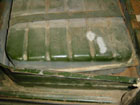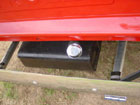What's this bad rap some people give the GM pickups with in-cab gas tanks? For 35 years GM protected these tanks from collisions by double wall reinforced cab metal, doors, and seat riser frames. The 1937-46 pickups even secured the tank under the seat and surrounded it on three sides by the welded to floor heavy gauge metal seat riser.
If you and your truck are ever involved in a collision so major that the gas tank begins leaking, then imagine what could be occurring if the tank was in most other places on the truck. Unless you have found a narrow tank that fits inside the frame rail and away from the drive shaft, you haven't located a safer location than what GM used between 1937 and 1972.
For approximately 18 months, beginning with the 1947, Advance Design body style, GM placed their pickup gas tanks under the bed inside the frame rail. This location, while protected from side impacts, was very susceptible to damage from road debris. Leaks from being hit by rocks and stumps soon caused GM to again place the tanks in the cab. Possibly, a protective panel would have given the tank a shield but GM did not use this option. The tank went back in the cab.
In these older trucks you instantly smelled gasoline if the sending unit gasket or gas filler hose began to fail. Trucks with under the bed tanks usually must be parked and dripping before a person smells the vapors.
Important: If you critique the early in-cab GM gas tanks, don't forget what General Motors did to the truck series beginning in 1973. Can you believe? They secured the tank in their pickups to the outside of the frame rail under the bed. The only separation from a broadside accident is the single layered sheet metal bedside! It doesn't take much of a side impact to flatten the tank with disastrous results.
SAFETY FIRST! GM had the right idea! This tank is protected by the original heavy steel seat riser surrounding it and then it sits within a double layer metal cab. Compare this with some people's idea of hanging their gas tank behind the rear axle with very little protection from a rear end hit.
REMEMBER: the Ford Pinto that was rear-ended in the 1970's burst into flames and the 2 Pinto passengers were killed? Yes, it came with a factory issued rear mounted gas tank! Check out this story on a Google search...
Don't make your truck more dangerous than it was originally!!

This photo shows an in cab under seat gas tank as used between 1937 -1946...It lays inside a heavy gauge metal seat riser as well as being inside of a heavy gauge double layer metal cab. (above)

The above photo was taken of a 1952 Chevrolet 1/2 ton daily driven pickup. The owner was so concerned about the gas tank in the cab that he placed it under the bed behind the rear axle. The non metal tank is just waiting for a rear end hit at about 20 miles per hour. The original bumper will offer little protection and the contents of the tank will fly in all directions...Is this a moving bomb ready to explode?


versandapotheke versandkostenfrei
versandapotheke deutschland